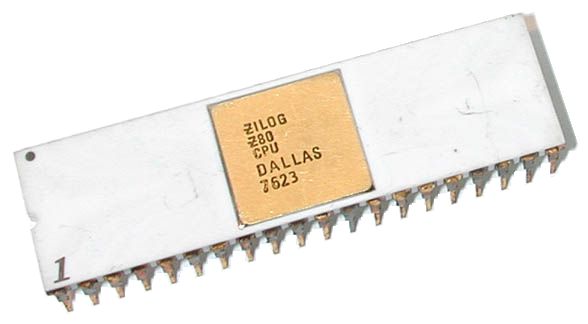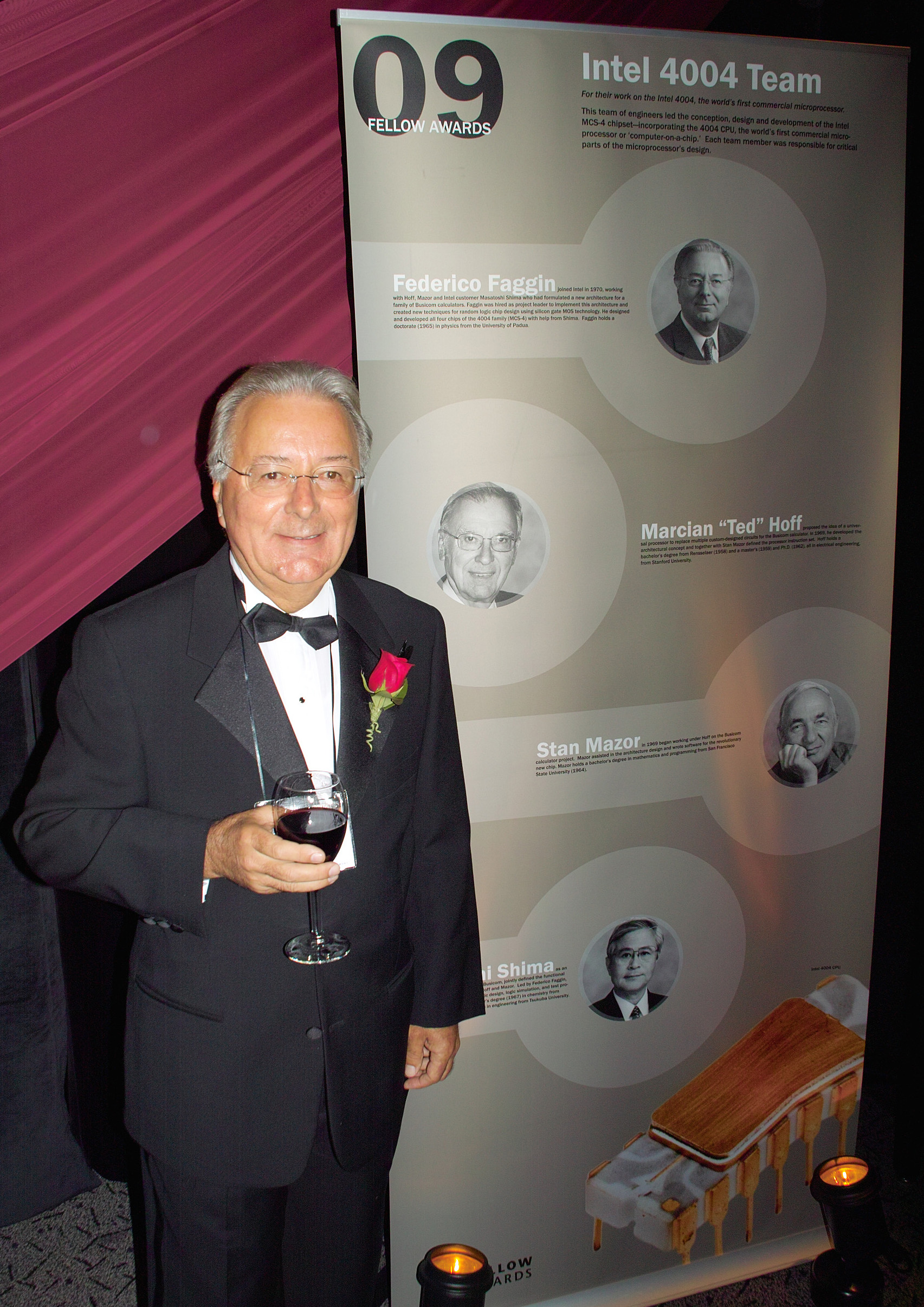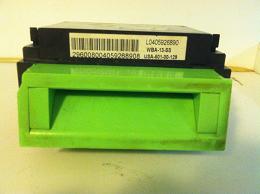|
Z80
The Z80 is an 8-bit microprocessor introduced by Zilog as the startup company's first product. The Z80 was conceived by Federico Faggin in late 1974 and developed by him and his 11 employees starting in early 1975. The first working samples were delivered in March 1976, and it was officially introduced on the market in July 1976. With the revenue from the Z80, the company built its own chip factories and grew to over a thousand employees over the following two years. The Zilog Z80 is a software-compatible extension and enhancement of the Intel 8080 and, like it, was mainly aimed at embedded systems. Although used in that role, the Z80 also became one of the most widely used CPUs in desktop computers and home computers from the 1970s to the mid-1980s. It was also common in military applications, musical equipment such as synthesizers (like the Roland Jupiter-8), and coin-operated arcade games of the late 1970s and early 1980s, including ''Pac-Man''. Zilog licensed the ... [...More Info...] [...Related Items...] OR: [Wikipedia] [Google] [Baidu] |
Zilog
Zilog, Inc. is an American manufacturer of microprocessors and 8-bit and 16-bit microcontrollers. It is also a supplier of application-specific embedded system-on-chip (SoC) products. Its most famous product is the Z80 series of 8-bit microprocessors that were compatible with the Intel 8080 but significantly cheaper. The Z80 was widely used during the 1980s in many popular home computers such as the TRS-80, MSX, Amstrad CPC and the ZX Spectrum, as well as arcade games such as ''Pac-Man''. The company also made 16- and 32-bit processors, but these did not see widespread use. From the 1990s, the company focused primarily on the microcontroller market. The name (pronunciation varies) is an acronym of ''Z integrated logic'', also thought of as "Z for the last word of Integrated Logic". In the oral history interview video which Federico Faggin (co-founder of Zilog) recorded for the Computer History Museum, he pronounced Zilog with a long "i" () consistently. History Zilog was ... [...More Info...] [...Related Items...] OR: [Wikipedia] [Google] [Baidu] |
Federico Faggin
Federico Faggin (, ; born 1 December 1941) is an Italian physicist, engineer, inventor and entrepreneur. He is best known for designing the first commercial microprocessor, the Intel 4004. He led the 4004 (MCS-4) project and the design group during the first five years of Intel's microprocessor effort. Faggin also created, while working at Fairchild Semiconductor in 1968, the self-aligned MOS ( metal–oxide–semiconductor) silicon-gate technology (SGT), which made possible MOS semiconductor memory chips, CCD image sensors, and the microprocessor. After the 4004, he led development of the Intel 8008 and 8080, using his SGT methodology for random logic chip design, which was essential to the creation of early Intel microprocessors. He was co-founder (with Ralph Ungermann) and CEO of Zilog, the first company solely dedicated to microprocessors, and led the development of the Zilog Z80 and Z8 processors. He was later the co-founder and CEO of Cygnet Technologies, and then ... [...More Info...] [...Related Items...] OR: [Wikipedia] [Google] [Baidu] |
Intel 8080
The Intel 8080 (''"eighty-eighty"'') is the second 8-bit microprocessor designed and manufactured by Intel Intel Corporation is an American multinational corporation and technology company headquartered in Santa Clara, California. It is the world's largest semiconductor chip manufacturer by revenue, and is one of the developers of the x86 ser .... It first appeared in April 1974 and is an extended and enhanced variant of the earlier Intel 8008, 8008 design, although without binary compatibility.'' Electronic News'' was a weekly trade newspaper. The same advertisement appeared in the :File:Intel 8080 Advertisement May 1974.jpg, May 2, 1974 issue of ''Electronics'' magazine. The initial specified clock rate or frequency limit was 2 Megahertz, MHz, with common instructions using 4, 5, 7, 10, or 11 cycles. As a result, the processor is able to execute several hundred thousand instructions per second. Two faster variants, the 8080A-1 (sometimes referred to as the 808 ... [...More Info...] [...Related Items...] OR: [Wikipedia] [Google] [Baidu] |
Mostek
Mostek was a semiconductor integrated circuit manufacturer, founded in 1969 by L. J. Sevin, Louay E. Sharif, Richard L. Petritz and other ex-employees of Texas Instruments. At its peak in the late 1970s, Mostek held an 85% market share of the dynamic random-access memory (DRAM) memory chip market worldwide, until being eclipsed by lower-priced Japanese DRAM manufacturers who were accused of dumping memory on the market. Initially Mostek products were manufactured in Worcester, Massachusetts in cooperation with Sprague Electric, however by 1974 most of its manufacturing was done in the Carrollton, Texas facility on Crosby Road. In 1979, soon after its market peak, Mostek was purchased by United Technologies Corporation for . In 1985, after several years of red ink and declining market share, UTC closed Mostek completely and sold it for to the French electronics firm Thomson-CSF, which later spun it off into STMicroelectronics. Early Products Mostek's first contract was from ... [...More Info...] [...Related Items...] OR: [Wikipedia] [Google] [Baidu] |
8-bit Computing
In computer architecture, 8-bit integers or other data units are those that are 8 bits wide (1 octet). Also, 8-bit central processing unit (CPU) and arithmetic logic unit (ALU) architectures are those that are based on registers or data buses of that size. Memory addresses (and thus address buses) for 8-bit CPUs are generally larger than 8-bit, usually 16-bit. 8-bit microcomputers are microcomputers that use 8-bit microprocessors. The term '8-bit' is also applied to the character sets that could be used on computers with 8-bit bytes, the best known being various forms of extended ASCII, including the ISO/IEC 8859 series of national character sets especially Latin 1 for English and Western European languages. The IBM System/360 introduced byte-addressable memory with 8-bit bytes, as opposed to bit-addressable or decimal digit-addressable or word-addressable memory, although its general-purpose registers were 32 bits wide, and addresses were contained in the lower 24 bits o ... [...More Info...] [...Related Items...] OR: [Wikipedia] [Google] [Baidu] |
Microprocessor
A microprocessor is a computer processor where the data processing logic and control is included on a single integrated circuit, or a small number of integrated circuits. The microprocessor contains the arithmetic, logic, and control circuitry required to perform the functions of a computer's central processing unit. The integrated circuit is capable of interpreting and executing program instructions and performing arithmetic operations. The microprocessor is a multipurpose, clock-driven, register-based, digital integrated circuit that accepts binary data as input, processes it according to instructions stored in its memory, and provides results (also in binary form) as output. Microprocessors contain both combinational logic and sequential digital logic, and operate on numbers and symbols represented in the binary number system. The integration of a whole CPU onto a single or a few integrated circuits using Very-Large-Scale Integration (VLSI) greatly reduced the c ... [...More Info...] [...Related Items...] OR: [Wikipedia] [Google] [Baidu] |
Pac-Man
originally called ''Puck Man'' in Japan, is a 1980 maze action video game developed and released by Namco for arcades. In North America, the game was released by Midway Manufacturing as part of its licensing agreement with Namco America. The player controls Pac-Man, who must eat all the dots inside an enclosed maze while avoiding four colored ghosts. Eating large flashing dots called "Power Pellets" causes the ghosts to temporarily turn blue, allowing Pac-Man to eat them for bonus points. Game development began in early 1979, directed by Toru Iwatani with a nine-man team. Iwatani wanted to create a game that could appeal to women as well as men, because most video games of the time had themes of war or sports. Although the inspiration for the Pac-Man character was the image of a pizza with a slice removed, Iwatani has said he also rounded out the Japanese character for mouth, kuchi ( ja, 口). The in-game characters were made to be cute and colorful to appeal to younger p ... [...More Info...] [...Related Items...] OR: [Wikipedia] [Google] [Baidu] |
Roland Jupiter-8
The Jupiter-8, or JP-8, is an eight-voice polyphonic analog subtractive synthesizer introduced by Roland Corporation in early 1981. The Jupiter-8 was Roland's flagship synthesizer for the first half of the 1980s. Approximately 3300 units have been produced. Although it lacked the soon-to-be standard of MIDI control, later production series of the Jupiter-8 did include Roland's proprietary DCB interface. The instrument had many advanced features for its time, including the ability to split the keyboard into two zones, with separate patches active on each zone. Two years after the release of the Jupiter-8, Roland released the more affordable Jupiter-6 synthesizer with built-in MIDI control but an otherwise slightly reduced set of features. In 2011, three decades after the release of the original Jupiter series, Roland released the fully digital Jupiter-80 and Jupiter-50 synthesizers as successors to the 1980s originals. They were in turn succeeded by the Jupiter-X and Jupite ... [...More Info...] [...Related Items...] OR: [Wikipedia] [Google] [Baidu] |
Backward Compatible
Backward compatibility (sometimes known as backwards compatibility) is a property of an operating system, product, or technology that allows for interoperability with an older legacy system, or with input designed for such a system, especially in telecommunications and computing. Modifying a system in a way that does not allow backward compatibility is sometimes called " breaking" backward compatibility. A complementary concept is forward compatibility. A design that is forward-compatible usually has a roadmap for compatibility with future standards and products. A related term from programming jargon is hysterical reasons or hysterical raisins (near-homophones for "historical reasons"), as the purpose of some software features may be solely to support older hardware or software versions. Usage In hardware A simple example of both backward and forward compatibility is the introduction of FM radio in stereo. FM radio was initially mono, with only one audio channel represented ... [...More Info...] [...Related Items...] OR: [Wikipedia] [Google] [Baidu] |
Embedded System
An embedded system is a computer system—a combination of a computer processor, computer memory, and input/output peripheral devices—that has a dedicated function within a larger mechanical or electronic system. It is ''embedded'' as part of a complete device often including electrical or electronic hardware and mechanical parts. Because an embedded system typically controls physical operations of the machine that it is embedded within, it often has real-time computing constraints. Embedded systems control many devices in common use today. , it was estimated that ninety-eight percent of all microprocessors manufactured were used in embedded systems. Modern embedded systems are often based on microcontrollers (i.e. microprocessors with integrated memory and peripheral interfaces), but ordinary microprocessors (using external chips for memory and peripheral interface circuits) are also common, especially in more complex systems. In either case, the processor(s) us ... [...More Info...] [...Related Items...] OR: [Wikipedia] [Google] [Baidu] |
Coin-operated
A currency detector or currency validator is a device that determines whether notes or coins are genuine or counterfeit. These devices are used in a wide range of automated machines, such as retail kiosks, supermarket self checkout machines, arcade gaming machines, payphones, launderette washing machines, car park ticket machines, automatic fare collection machines, public transport ticket machines, and vending machines. The process involves examining the coins and/or notes that have been inserted into the machine, and conducts various tests to determine if the currency is counterfeit. Because the parameters are different for each coin or note, these currency acceptors must be correctly programmed for each item to be accepted. In normal operation, if any item such as a coin, banknote, card or ticket is accepted, it is retained within the machine and it falls into a storage container to allow a member of staff to collect it later when emptying the machine. If the item is re ... [...More Info...] [...Related Items...] OR: [Wikipedia] [Google] [Baidu] |
Synthesizer
A synthesizer (also spelled synthesiser) is an electronic musical instrument that generates audio signals. Synthesizers typically create sounds by generating waveforms through methods including subtractive synthesis, additive synthesis and frequency modulation synthesis. These sounds may be altered by components such as filters, which cut or boost frequencies; envelopes, which control articulation, or how notes begin and end; and low-frequency oscillators, which modulate parameters such as pitch, volume, or filter characteristics affecting timbre. Synthesizers are typically played with keyboards or controlled by sequencers, software or other instruments, and may be synchronized to other equipment via MIDI. Synthesizer-like instruments emerged in the United States in the mid-20th century with instruments such as the RCA Mark II, which was controlled with punch cards and used hundreds of vacuum tubes. The Moog synthesizer, developed by Robert Moog and first sol ... [...More Info...] [...Related Items...] OR: [Wikipedia] [Google] [Baidu] |









